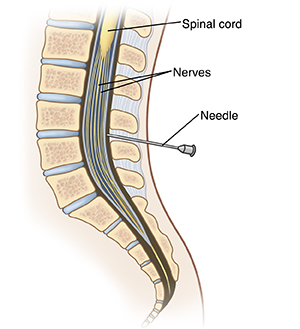A lumbar puncture is also called a spinal tap. It's done to test samples of the fluid that surrounds your brain and spinal cord. This fluid is called cerebrospinal fluid (CSF). This test can be used to look for signs of infection, inflammation, or cancer in the nervous system. It's also used to look for signs of bleeding in the space around the brain. Or it can be done to measure the pressure on the brain. Sometimes a spinal tap is done to remove fluid as treatment for various disorders. This procedure will be done by or supervised by ______________________________________.
What happens during the procedure?
A lumbar puncture is a common test. It usually isn’t more painful than getting a shot. Your skin will be cleaned with an antiseptic solution. The health care provider will then use medicine to numb a small area of skin on your lower back. They will insert the spinal needle there. In infants, the numbing medicine usually isn’t used. This is because the infant spinal needle is very small and usually hurts less.
The provider will place the needle between the bones of your lower spine, and into the spinal canal below the end of the spinal cord. There is very little danger of harming the spinal cord during this procedure. In some cases, X-rays are used to guide where to put the needle. The provider will take out some spinal fluid and collect it in tubes. Then they will remove the needle. After the procedure, the provider might ask you to stay lying down for 30 minutes or more. The procedure often takes about 10 to 15 minutes. It can take longer if you have problems related to positioning or have degenerative changes in the spine.
Risks for the procedure
All medical procedures have risks. The risks for this test are small compared with the dangers of not diagnosing certain conditions, such as meningitis (a brain infection), bleeding in the brain, or cancer.
Problems are not common after a lumbar puncture. But they may include:
-
Bruising. It’s possible to break a small blood vessel near the skin during the procedure. There may be bruising. This is not a serious problem. It will go away on its own.
-
Infection. Skin bacteria can infect the puncture site. To help prevent this, your skin is cleaned with an antiseptic solution. And only sterilized tools are used.
-
Headache that gets worse. In some cases, the lumbar puncture may cause a headache. Or it can cause an existing headache to get worse. This may happen if spinal fluid leaks internally from the puncture into the spinal canal. When you get home, rest as your provider tells you to. Lie flat and drink plenty of fluids. This may help ease a headache if you have one. For some people, the headache continues and needs treatment with a blood patch. This is an injection of your own blood into the puncture site.
-
Bleeding. You have a small risk of minor bleeding where the needle is put through the skin. This bleeding usually stops with mild pressure by your provider. You also have a small risk of bleeding around the spinal canal, but this is rare. Rarely, bleeding could injure nerves or the spinal cord from pressure inside the spinal canal. If you have a condition that causes you to bleed easily or are taking daily blood thinners such as aspirin or warfarin, tell your provider before the procedure.
-
Back pain. You may have back pain, usually where the needle is inserted. This can happen after the procedure. This usually goes away after 1 to 2 days. You can treat it with an over-the-counter pain medicine.
-
Herniation. In rare cases, brain herniation can happen if this procedure is done while there is swelling in the brain. Herniation means that part of the brain is compressed and damaged because of the swelling in the brain. Your provider will make sure you have no brain swelling before doing a lumbar puncture.
-
Epidermoid tumor. Rarely, a small piece of skin can be carried in the CSF by a hollow needle. There, it can form a benign tumor called epidermoid tumor or epidermoid cyst. This is usually discovered years after the lumbar puncture.
Consent
By signing this form, you agree that:
You have been given information about the risks and benefits of lumbar puncture and alternatives to it. You have had a chance to discuss this with your health care provider. You consent to having a lumbar puncture at this time.
Signature: _________________________________________________________
(Patient/parent/guardian) (Relationship to patient)
Witness: __________________________________________________________


